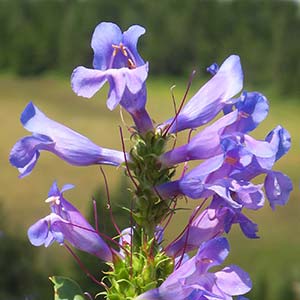|
Blue Mountains beardtongue, Pennell's beardtongue
|
egg-leaf beardtongue, broad-leaved penstemon
|
| Glabrous perennial from a branched crown, with several stout stems 2-6 dm. tall. |
Robust perennial from a woody base, the clustered stems 3-10 dm. tall, with stiff, spreading hairs below the inflorescence |
Leaves opposite, entire, the basal ones clustered, up to 27 cm. long and 4 cm. wide, petiolate, the blade lanceolate or narrowly elliptic; cauline leaves mostly sessile, broad and clasping. |
Basal leaves opposite, clustered, petiolate, with ovate to sub-cordate blade up to 10 cm. long and half as wide, about equaling the petiole, serrate, hairy like the stem, especially along the mid-vein beneath; cauline leaves sessile and clasping, more sharply serrate, nearly as large, but more broadly oblong, the upper ovate. |
Inflorescence of several verticillasters; calyx 5-cleft nearly to the base, 6-9 mm. long, the segments narrow and acuminate; corolla bilabiate, bright blue, 25-33 mm. long, about 1 cm. wide at the mouth, glabrous; pollen sacs 1.9-2.5 mm. long, divaricate, twisted, dentate along the sutures, the inner end indehiscent; fertile stamens 4; sterile stamen short-bearded toward the tip. |
Inflorescence large and open, strongly glandular-hairy; calyx 3-5 mm. long, broadly lanceolate, with parallel veins; corolla blue, 15-22 mm. long, glandular-hairy on the outside, the raised portion of the lower petal pale blue and hairy; corolla strongly bilabiate, the lower lip much the longer; pollen sacs 0.8-1.1 mm. long, fully dehiscent and becoming opposite, nearly glabrous; staminode bearded toward the recurved tip. |
Capsule 9-12 mm. long. |
Capsule 4-6 mm. long. |
|
|
|
|
| May-June |
May-August |
| Open, gravelly and sandy slopes and ridges, sometimes associated with ponderosa pine forest openings, at middle elevations. |
Open woods below 3000 feet in elevation. |
Occurring east of the Cascades crest in the Blue Mountains of southeastern Washington; southeastern Washington to the Blue Mountains in adjacent northeastern Oregon.
|
Occurring on both sides of the Cascades crest in Washington; southern British Columbia to Oregon.
|
| Native |
Native |
| Sensitive in Washington (WANHP) |
Not of concern |
P. acuminatus, P. attenuatus, P. barrettiae, P. cardwellii, P. cinereus, P. confertus, P. davidsonii, P. deustus, P. ellipticus, P. eriantherus, P. euglaucus, P. fruticosus, P. gairdneri, P. glandulosus, P. hesperius, P. lyallii, P. ovatus, P. palmeri, P. procerus, P. pruinosus, P. richardsonii, P. rupicola, P. rydbergii, P. serrulatus, P. speciosus, P. subserratus, P. triphyllus, P. venustus, P. washingtonensis, P. wilcoxii |
P. acuminatus, P. attenuatus, P. barrettiae, P. cardwellii, P. cinereus, P. confertus, P. davidsonii, P. deustus, P. ellipticus, P. eriantherus, P. euglaucus, P. fruticosus, P. gairdneri, P. glandulosus, P. hesperius, P. lyallii, P. palmeri, P. pennellianus, P. procerus, P. pruinosus, P. richardsonii, P. rupicola, P. rydbergii, P. serrulatus, P. speciosus, P. subserratus, P. triphyllus, P. venustus, P. washingtonensis, P. wilcoxii |
| |



